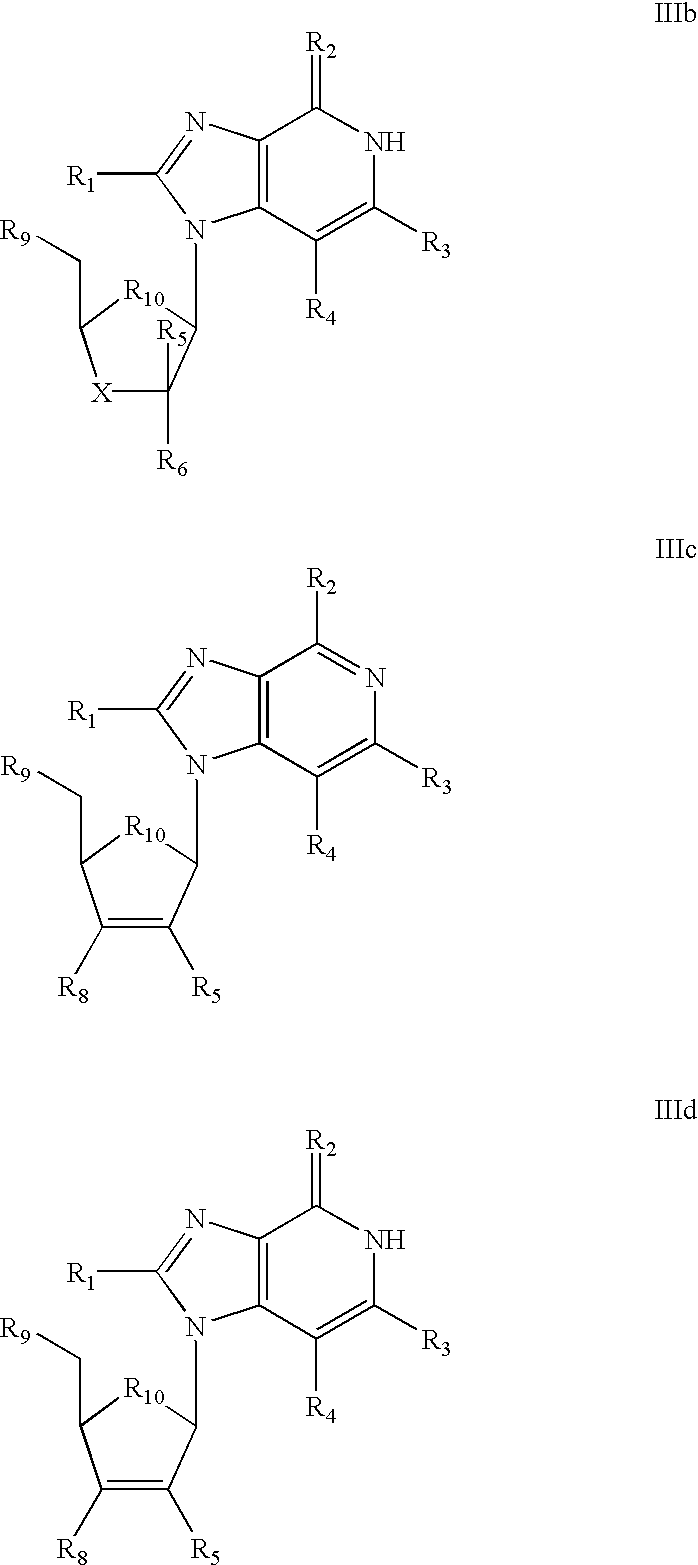Selective anti-viral nucleoside chain terminators
- Summary
- Abstract
- Description
- Claims
- Application Information
AI Technical Summary
Benefits of technology
Problems solved by technology
Method used
Image
Examples
example 1
2-Amino-5-iodopyridine (2)
[0070]The iodo compound 2 was prepared by a standard method. A mixture of 2-aminopyridine (1) (2.4 g, 25 mmol), periodic acid dihydrate (0.86 g, 3.75 mmol), and iodine (2.7 g, 10.7 mmol) were heated in a mixed solution of acetic acid (60 ml), water (3 ml), and sulfuric acid (0.5 ml) at 80° C. for 4 h. It was then poured into 10% aqueous Na2S2O3 solution to remove unreacted iodine and extracted with ether. The extract was washed with 10% aqueous NaOH, dried (K2CO3), and concentrated in vacuo. The residue was purified by flash chromatography on silica gel (eluted with ethyl acetate / hexanes 5:2; Rf=0.64), followed by recrystallization from ethanol to give colorless prisms of compound 2 (83% yield, 4.6 g). UV-vis: max (CH3OH) 247 (46330), 314 nm (7970); IR (KBr): 3377(s), 3301(s), 3144(sb), 3012(m), 1640(s), 1577(s), 1545(s), 1483(s), 1381(s), 1312(s), 1256(s), 1142(s), 1086(s), 998(s), 828(s), 526(s), 457(s)cm −1; 1H NMR (400 MHz, CDCl3, ppm): 8.21(s,1H), 7.62...
example 2
5-(-D-glyceropentofuran-3′-ulos-1′-yl)-2-amino-pyridine (5)
[0071]A mixture of bis(dibenzylideneacetone)palladium(0) (0.115 g, 0.2 mmol) and tris(pentafluorophenyl)phosphine(0.213 g, 0.4 mmol) in acetonitrile (60 ml) was stirred under nitrogen at room temperature for 30 min. Then, N,N-diisopropylethylamine (1.4 ml, 8 mmol), 1,4-anhydro-2-deoxy-3-O-(1,1-dimethylethyl)diphenylsilyl-D-erythro-1-enitol (3) (1.42 g, 4 mmol) and 2 (0.880 g, 4 mmol) were added in above mixture. The resulting reaction solution was refluxed under nitrogen at 95° C. for 30 h. The volatiles were removed in vacuo. The residue was purified by flash chromatography on silica gel (eluent: methylene chloride / methanol =9:1, Rf=0.37) to yield intermediate 4 (1.7 g, 92% yield) as colorless foam slightly contaminated by trace amount of N,N-diisopropylethylamine . The characteristics of 4 is as follows: 1H NMR (400 MHz, CDCl3, ppm): 7.86-7.83(m, 2H), 7.77-7.72(m, 3H), 7.47-7.741(m, 6H), 7.07(dd, 1H, J=2.4 Hz), 6.27(d, 1H,...
example 3
5-((−)-D-glyceropentofuran-3′-ulos-1′-yl)-2-aminopyridinc p-toluenesulfonyl-hydrazone (6)
[0073]To 1 g(4.8 mmoles) of compound 5 in 30 ml of methanol was added 1.8 g(9.6 mmoles) of p-toluenesulfonylhydrazide. The solution was stirred at room temperature for overnight. Crystallization from methanol gave hydrazone compound 5 (1.75 g, yield 97%). UV-vis: max (CH3OH) 273, 300 nm; IR(KBr): 3741(s), 3370(s), 3213(s), 3026(m), 2923(m), 2845(m), 1677(s), 1639(s), 1515(m), 1337(s), 1167(s), 1041(s), 941(m), 551(s)cm−1; 1H NMR (400 DMSO, ppm) 10.33(sb, 1H), 7.86(d, 1H, J=1.6 Hz), 7.71(d, 2H, J=8 Hz), 7.40-7.38(m, 3H), 6.41(d, 1H, J=8.4 Hz), 5.96(s, 2H), 4.76-4.72(m, 2H), 4.20-4.19(m, 1H), 3.61-3.57(m, 1H), 3.39-3.31(m, 1H), 2.92(dd, 1H, J1=6 Hz, J2=17.6 Hz), 2.29(ddd, 1H, J1=2 Hz, J2=10 Hz, J3=17.6 Hz); 13C NMR (100 MHz, DMSO, ppm): 161.52, 159.53, 146.29, 143.03, 135.92, 135.51, 129.25, 127.18, 123.01, 107.58, 80.73, 76.55, 62.85, 36.93, 21.09; MP: 150° C. decomp.; HRMS: calculated for C17H21...
PUM
| Property | Measurement | Unit |
|---|---|---|
| Toxicity | aaaaa | aaaaa |
Abstract
Description
Claims
Application Information
 Login to View More
Login to View More - R&D
- Intellectual Property
- Life Sciences
- Materials
- Tech Scout
- Unparalleled Data Quality
- Higher Quality Content
- 60% Fewer Hallucinations
Browse by: Latest US Patents, China's latest patents, Technical Efficacy Thesaurus, Application Domain, Technology Topic, Popular Technical Reports.
© 2025 PatSnap. All rights reserved.Legal|Privacy policy|Modern Slavery Act Transparency Statement|Sitemap|About US| Contact US: help@patsnap.com



